The 12 Oldest Dog Breeds
April 27, 2021 2021-06-04 8:10Earlier this year, the American Kennel Club allowed a new breed of dog into its ranks. The Biewer (trounced Beaver) terrier became the 197th breed recognized by the organization. It’s a mere pup of a breed, especially when compared to the oldest breeds of dogs, some of which have existed for thousands of years, or so we’re told.
Now we know what the newest breed of dog is, let’s find out which are the oldest.
For a long time, researchers believed the Basenji was the oldest breed, pointing out some Libyan cave paintings that depict the hunting dog and date back to approximately 6,000 BC. Last year, however, a new genetic study conducted by an international team of researchers indicated that the Greenland Sled Dogs were around long before the Basenji took its first breath.
By studying the 9,500-year-old remains of a dog found on the remote island of Zhokhov off the coast of Siberia, researchers thought they would find a primitive dog but instead, the Greenland Sled dog was already “a long way down the path to domestication.”
So, how does this affect our concept of the oldest dog breeds, and which breed has the Zhokhov dog knocked off its ancient pedestal?
Table of Contents
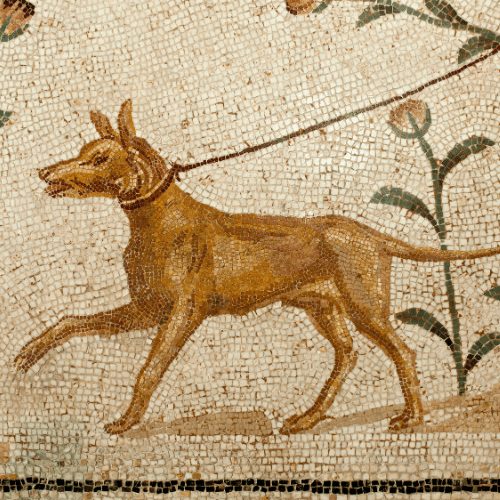
The 12 oldest dog breeds
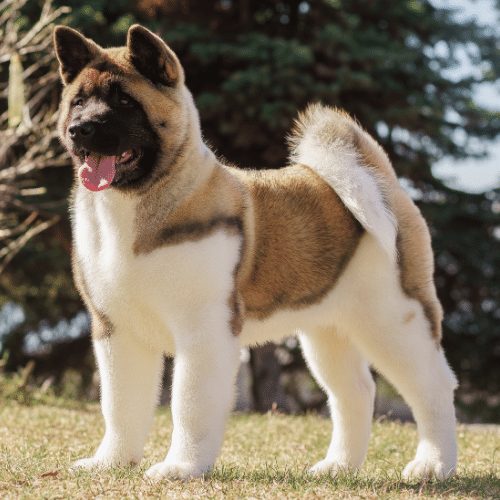
Akita Inu – 10,000 years
Despite the new research on the Greenland sled dog, the Akita (a type of Husky) manages to hold on to its top spot as the oldest breed of dog in the world.
Canine remains found at the Kamikuroiwa Rock Shelter site in Ehime are believed to date back to the Jomon Period which is traditionally dated between 14,000–300 BC. Although the breed of dog is unclear, the damage to the teeth lead researchers to conclude that these dogs were used for hunting large game mammals.
Although these dogs were smaller than the modern-day Akita Inu, or Japanese Akita, there’s no denying the breed’s rich history and lineage. After originating in the mountains of Japan, the Akita became domesticated and was trained to hunt large game, like wild boar and elks. Later, they served as loyal companions to the samurai.
Smaller than the American Akita, the Akita Inu has a more fox-like appearance, as opposed to the bear-shaped head of the more muscular American breed. Known for their “dignity, courage, and loyalty,” the Akita is a national monument of Japan where they are “venerated as family protectors and symbols of good health, happiness, and long life.”
Greenland Sled Dog – 9,500 years
Although not recognized as a breed by the AKC, the Greenland sled dog has a similar appearance to the Husky and Alaskan Malamute. Genetically speaking, however, it’s very different, having adapted to “eating a very high-fat diet, running and pulling sleds in a low-oxygen environment, and the ability to highly regulate their body temperatures.”
In this sense, they are more closely related to the dog discovered in Zhokhov and, unlike other dog breeds, show no signs of interbreeding with the gray wolf in the past 9,500 years.
According to researchers, the fact that Greenland sled dogs lack the genetic adaptations other breeds have made to cope with diets heavy in sugar and starch “emphasizes that sled dogs and Arctic people have worked and adapted together for more than 9,500 years.”
Since 2018, however, the Greenland sled dog has seen a dramatic population decline that could lead to extinction. Climate change has made traditional hunting methods ineffectual and caused a decline in available food sources. At the same time, epidemics of parvovirus and distemper have destroyed many subpopulations.
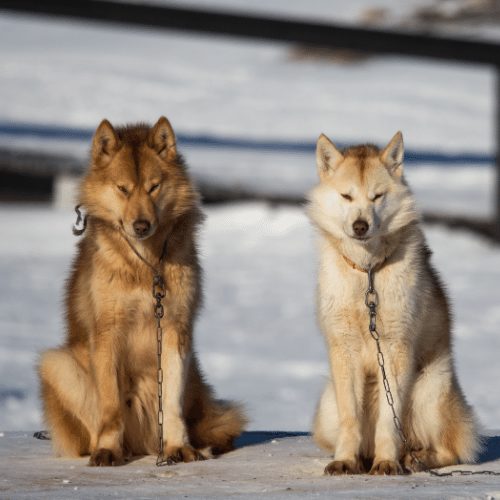
A strong, willful, and muscular dog, the Greenland sled dog has spent thousands of years working with humans – let’s hope something can be done to ensure it carries on for many more to come.

Afghan Hound – 8000 years
While many believe that the Afghan Hound originated in the deserts of Egypt, its name suggests otherwise, and a more realistic theory is that they were bred by the nomadic people of Afghanistan and its neighboring regions.
As fast and powerful as any other breed of sighthound, the Afghan was originally used to hunt game, including antelopes and, according to some, leopards. Eyewitnesses say the Afghan would grab its dangerous prey by the neck, “severing the leopards’ spines in their jaws.”
Afghan hounds caught the eye of British soldiers who took them back to the UK with them, exhibiting them at dog shows under various names, including Persian Greyhounds and Barukzy hounds.
Closely related to the Saluki, Afghans have an independent streak that harks back to their hunting origins and can be stubborn and aloof. These traits make them difficult to train, especially as they have an exceptionally high prey drive.
With its long, flowing locks and striking appearance, the Afghan Hound is a champion in the showing and makes for a loyal and entertaining companion that can be both quiet and dignified and downright clownish as the mood takes him.
Greyhound – 8000 years
Closely related to the sighthounds depicted in the temple drawings from 6,000 BC discovered in present-day Turkey, the Greyhound is one of the oldest dog breeds in the world.
While some are convinced the dog depicted on graves, inscriptions, and tomb paintings was, in fact, a Greyhound, others believe it has more in common with the Basenji or Saluki.
There’s no doubt that the Greyhound descended from these ancient Egyptian predecessors, taking on the role of hunter, as well as companion and guard dog.
By the Middle Ages, the Greyhound was nearly extinct, as widespread famine swept across Europe. The breed was saved by clergymen who went on to breed them for nobility, giving the Greyhound its revered status as a companion to the aristocracy.
Intelligent, independent, and fleet-footed, the Greyhound is a gentle, affectionate dog that is eager to please.

A high prey drive means they’re not the easiest dogs to have around if you’ve got rabbits or guinea pigs, but if you want a quiet, mild-mannered companion, a Greyhound is ideal.
Greyhounds also make great running partners – as long as you don’t try to keep up with them – and, with their speed and dexterity excel at both agility and obedience.
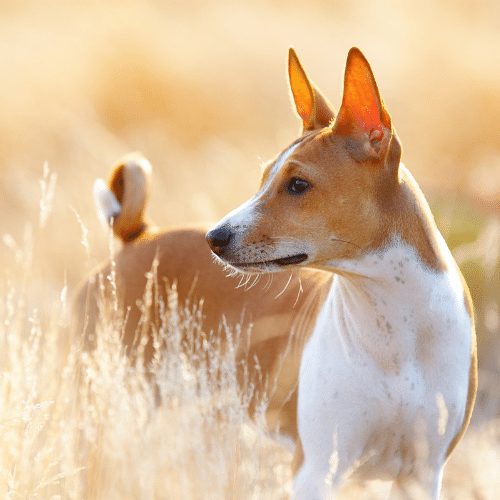
Basenji – 5000 years
Like the Greyhound, the Basenji is believed to be related to the dogs of Ancient Egypt, although others claim it originated in Africa.
Having been isolated in remote regions, the Basenji has maintained many of the unusual traits of its ancient predecessors and displays more catlike behavior than most dog breeds.
Not only does the Basenji lack that distinctive doggy smell, but it also yodels rather than barks and is as fastidious about its appearance and cleanliness as a cat.
It’s believed that the Basenjis were once prized “as versatile hunters with keen eyesight, explosive speed, and a highly developed sense of smell.”
To cope with the tall grasses of the African savanna, the breed also developed a unique ability to leap vertically in the air. One of its African names translates as “the jumping-up-and-down dog.”
Something of a “cult breed,” the Basenji made it into 86th place in the AKC’s list of the most popular breeds of 2020. Clean, odor-free, intelligent, and inquisitive Basenjis are excellent guard dogs and loyal companions.
Constantly alert, the Basenji needs plenty of exercise and mental stimulation but will reward your efforts with their entertaining and amusing personalities.
Tibetan Mastiff – 5000 years
Mastiffs of all types (such as the Korean Mastiff) have been around for thousands of years but the Tibetan is believed to be the oldest.
A phylogenetic analysis performed in 2008 lead researchers to conclude “that the approximate divergence time between Tibetan Mastiff and the gray wolf was 58,000 years before the present (YBP), and the approximate divergence time between other domestic dogs and the gray wolf was 42,000 YBP.”
The Mastiff is one of the oldest dogs, and it’s believed to have descended from the war dogs of ancient Rome, although there is little genetic evidence to support this theory. Nevertheless, they do share a certain likeness with the legendary Molossus which Aristotle described as being both larger than other dogs “and more fierce in their attack on wild beasts.”
Tibetan Mastiffs were originally used as guard dogs, protecting both property and livestock, so it’s hardly surprising that they are very territorial dogs. While gentle and affectionate with family members, Tibetan Mastiffs can be aggressive towards strangers and, as a result, have been banned in parts of the US, France, and Australia, among other places.
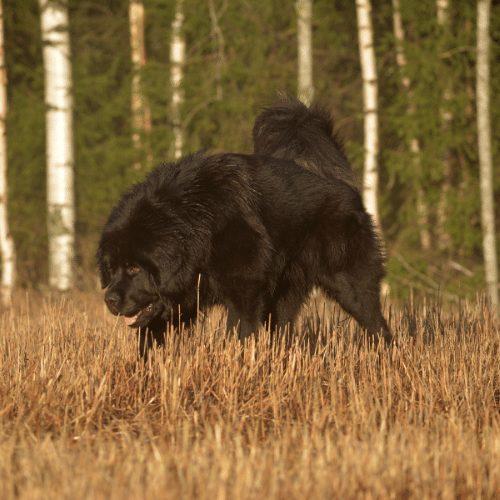
Despite such bans, the Tibetan Mastiff remains a popular breed, celebrated for its intelligence, independence, strength, and loyalty. Because of their tendency to display potentially reactive behavior, keep your Mastiff on a collar and leash at all times.
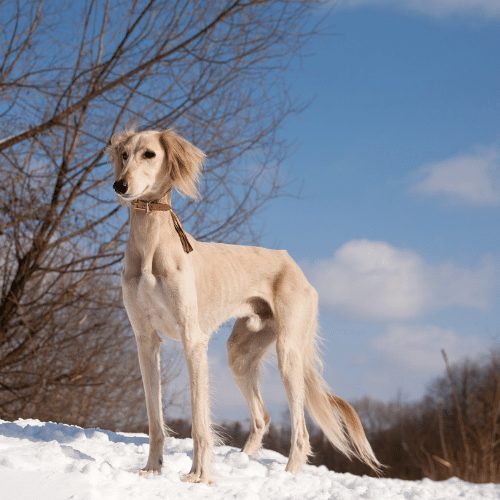
Saluki – 5000 years
The Saluki currently holds the Guinness World Record for being the oldest breed of dog in the world.
Although new research may have undermined that claim, its ancient origins are undeniable. Archaeologists uncovered a golden pendant depicting a Saluki that dated back to 3,300BCE while the remains of mummified Salukis have been discovered in ancient tombs in the Upper Nile region.
These elegant dogs were highly valued by Arab tribesmen and Egyptian nobility alike. As high-speed sighthounds, they were prized for their speed, endurance, and keen hunting instinct.
Capable of reaching speeds of up to 42 mph, the Saluki was most famously used to hunt gazelle but, in the mountainous terrain of northern Iran and Turkey, it adapted to the environment, becoming “bigger, heavier, [and] hairier” to cope with larger prey, like deer.
Curious, loyal, and yet independent, the Saluki is an athletic dog that excels in competition, showing an aptitude for activities such as agility, lure coursing, and jumping. Despite their hunting origins and high prey drive, Salukis make dignified and gentle family pets as long as they get plenty of exercise and mental stimulation.
Alaskan Malamute – 3000 years
Thousands of years ago, the forebears of the Alaskan Malamute crossed from Siberia into Alaska, where it developed into a breed similar to the one we know today. Used to pull sleds, hunt seals, and defend against polar bears, the Alaskan Malamute was highly valued.
Its name is derived from the name of the Inuit people, the Mahlemiut, who inhabited the northwestern region of Alaska known as Kotzebue Sound.
Being an isolated tribe meant that the Alaskan Malamute survived the Gold Rush of 1896 relatively intact, although cross-breeding almost caused the breed’s extinction.
Fortunately, the Alaskan Malamute proved more capable of surviving the cold weather and harsh winters of Alaska – a characteristic that ensured its continued survival.
A powerful and athletic breed, the Malamute is known for its endurance and ability as a working dog, but they also make great pets. Playful and occasionally mischievous, the Alaskan Malamute is a wonderful family companion for experienced dog owners.
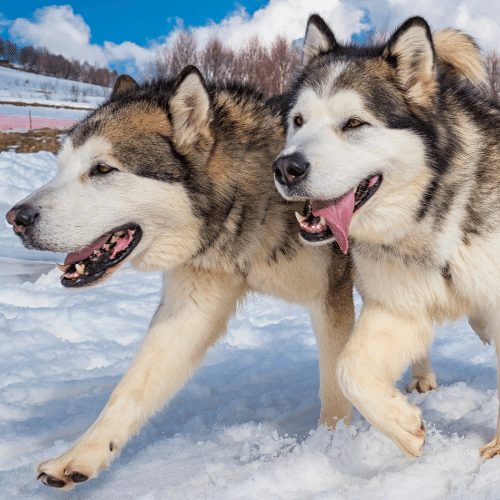
They often participate in agility and obedience trials and need plenty of vigorous exercise. Their friendly temperaments make them poor watchdogs but loving companions, although they can become destructive if not given adequate exercise.
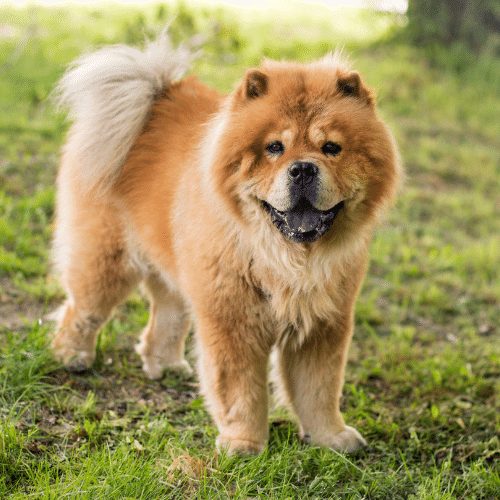
Chow Chow – 2000 to 3000 years
The distinctive Chow Chow originated in China where they were used “as retrievers, pointers, and sled dogs.” Depictions of the breed have been found on sculptures and Chinese pottery dating back to the Hun dynasty (206 BC until 22 AD).
Although the true origin of the breed is unknown, it’s believed they were bred as guard dogs, and as a gastronomic delicacy. Some even say that the name Chow Chow is derived from the Chinese word ‘chou’ meaning edible.
The Chow Chow is famous for its distinctive blue or black tongue – a characteristic it shares with only one other breed, the Shar-Pei. Quite where it came from, however, no one seems to know, although folk tales suggest that “Chow Chows were allowed to lick up all the little pieces of blue sky that fell on the earth when the stars were set in their places,” when the world was being created.
Marco Polo was one of the first to mention the unusual Chow Chow, describing it as strong and confident, and yet “sweet and affectionate”. They are also fastidiously clean, easy to house train, and adaptable, making them as suited to country life as they are to living in a city.
Chows are quite expensive dogs – if you want one, be prepared to pay between $1,500 and $3,000 for a puppy from health-tested parents.
Poodle – 2,000 years
Although we tend to think of the Poodle as a French dog, some believe it originated in Germany as early as the 15th century.
Images of the Poodle from that era bear little resemblance to the Standard Poodle we know today, looking considerably more lion-like than today’s breed. This breed comes in a wide variety of colors, with some (such as the Parti Poodle or Phantom Poodle) being highly sought-after.
Wherever the breed began its existence, it started as a water and hunting dog, specifically to retrieve waterfowl. These early Poodles were clipped for practical reasons, and “the long hair around the chest provided insulation for the dog’s vitals in freezing water, [while] the shorn hindquarters reduced drag whilst swimming.”

The Poodle’s success in the show ring has led to it being ridiculed for its highly coiffed appearance and labeled an “elitist” breed. In fact, the Poodle is an intelligent and athletic breed that enjoys roughhousing as much as the next dog.
Poodles generally have a happy, gentle demeanor that make them ideal family pets. Easy to train, the Poodle excels in many disciplines and is as adept at hunting out truffles as it is at performing circus tricks.
This energetic breed thrives on both social and physical stimulation and competes successfully in almost every discipline, from showing to dock diving.
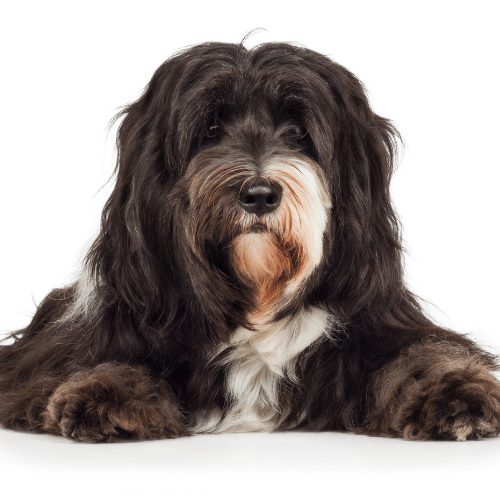
Tibetan Terrier – 2000 years
The Tibetan Terrier is a medium-sized dog with a shaggy coat that spent over 2,000 years evolving in the remote Himalayan mountains.
Known as the Holy Dog of Tibet, the Tibetan Terrier has been serving Tibetan monks for centuries, acting as a companion, watchdog, and good luck charm. It’s even said that, when forced to flee Tibet, the Dalai Lama took his beloved Tibetan Terrier, Senge, with him.
Although not a true terrier, the Tibetan Terrier, or Tsang Apso, is both sure-footed and fearless. It’s believed to be an ancestor of the curly-coated Puli and was used to herd sheep along narrow mountain passes, jumping on the backs of the animals to move them along.
Tibetan Terriers were believed to bring good fortune to their owners and, as a result, were never sold or crossed with other breeds. These days, you can purchase one of these shaggy dogs, but in ancient Tibet, the only way to obtain one was to receive it as a gift.
A gentle yet fun-loving breed, the Tibetan Terrier can adapt to a variety of lifestyles and homes, as long as it’s got some humans around to keep it company.
Pekingese – 2000 years old
There’s more to this small, fluffy breed than meets the eye and the Pekingese were once revered by royals as the ultimate lap dog and companion.
Legend has it that Buddha himself created this breed by shrinking a lion down to dog size. Some say this story contains “a grain of probable truth” in that the Pekingese was probably bred down to toy size from a larger breed.
However it came to be, the Pekingese quickly became a favorite amongst Chinese Emperors and their courtiers.
Believed to have been around since around 700 AD, this ancient breed has never regained the popularity it had in its early years, although “they are still much beloved companions and alert watchdogs.”
Requiring little exercise and even less food, the Pekingese is an easy dog to care for. Even its long, flowing locks require less grooming than other long-haired breeds, like the Afghan, for instance.
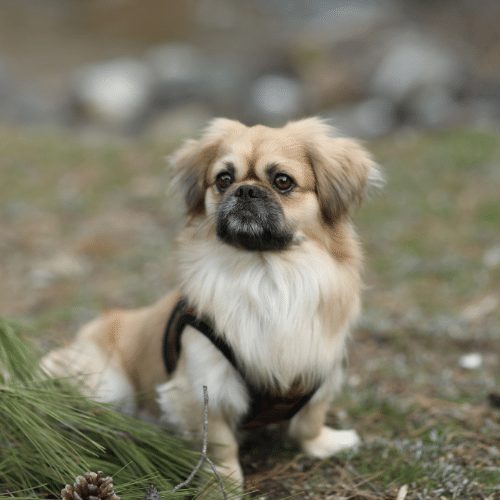
Despite its small size, the Pekingese is a confident, opinionated dog that can get a little big for its boots from time to time. They are, nevertheless, friendly, outgoing dogs that are both loyal and affectionate.
What Is The Oldest Dog Breed?
While many believe the Akita Inu is the oldest breed of dog, some scientific studies suggest that the Basenji emerged first.
Prehistoric cave paintings dating back as far as 6,000BC show images of Basenji, but these are far more modern than the Akita remains discovered at the Kamikuroiwa Rock Shelter site.
Similarly, although the Saluki holds the Guinness World Record for being the oldest breed of dog, having emerged in 329 BC or thereabouts, it can’t compete with the prehistoric origins of the Akita.
As genetic research continues, we can expect more insights into when the first domesticated dog came into existence and what its role was in ancient civilizations.
Are All Dogs Descended From the Wolf?
The Canis familiaris is directly descended from the gray wolf or Canis lupus. Despite the extraordinary variety of domestic dogs, all of them can be traced back to the gray wolf, although their appearance and behavior have changed dramatically over the years.

What Dog Breed Lives The Longest?
While it’s difficult to pinpoint the breed that lives the longest, there are some breeds of dogs that naturally outlive others. The Great Dane, for instance, has a very short lifespan, with an average life expectancy of around 8 to 10 years. The Chihuahua, on the other hand, usually survives for at least 12 years, sometimes reaching 20 years of age.
The oldest dog in the world, according to the Guinness World Records, was born in 1910 and lived for an incredible 29 years. Bluey, an Australian Cattle Dog, worked with sheep and cattle for 20 years before being put to sleep in November 1939.
Other long-living breeds include the Maltese at 12 to 15 years and the tenacious Jack Russell terrier at 13 to 16 years.

